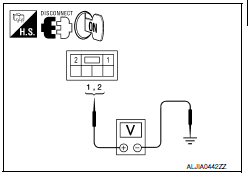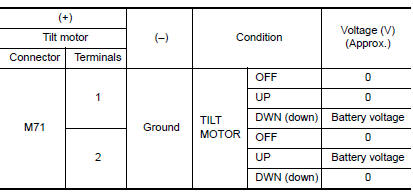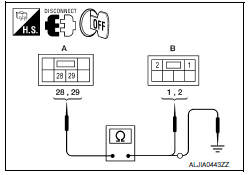Nissan Maxima Service and Repair Manual: Tilt motor
Description
- The tilt motor is installed to the steering column assembly.
- The tilt motor is activated with the automatic drive positioner control unit.
- The steering column is tilted upward/downward by changing the rotation direction of tilt motor.
Component Function Check
1. CHECK FUNCTION
- Select "TILT MOTOR" in "ACTIVE TEST" mode with CONSULT.
- Check the tilt motor operation.

Diagnosis Procedure
1. CHECK TILT MOTOR POWER SUPPLY

- Turn ignition switch OFF.
- Disconnect tilt motor.
- Turn the ignition switch ON.
- Perform "ACTIVE TEST" ("TILT MOTOR") with CONSULT.
- Check voltage between tilt motor harness connector and ground.

2. CHECK TILT MOTOR CIRCUIT

- Turn ignition switch OFF.
- Disconnect automatic drive positioner control unit.
- Check continuity between automatic drive positioner control unit harness connector and tilt motor harness connecto

- Check continuity between automatic drive positioner control unit harness connector and ground.

 Lifting motor (rear)
Lifting motor (rear)
Description
The lifting motor (rear) is installed to the seat frame.
The lifting motor (rear) is activated with the driver seat control
unit.
The seat lifter (rear) is moved upward/downward ...
 Telescopic motor
Telescopic motor
Description
The telescopic motor is installed to the steering column assembly.
The telescopic motor is activated with the automatic drive
positioner control unit.
Compresses the steering co ...
Other materials:
Manual shift mode
The transmission enters the manual shift mode by
moving the shift lever to the left side in the "D"
range. You can select the manual shift range
either by moving the shift lever up or down, or by
pulling the right-side or left-side paddle shifter (if
so equipped). To cancel the manual shift ...
Trunk open function
TRUNK LID OPENER SWITCH
TRUNK LID OPENER SWITCH : System Diagram
TRUNK LID OPENER SWITCH : System Description
TRUNK LID OPENER OPERATION
When trunk lid opener switch is ON, BCM opens trunk release solenoid.
BCM can open trunk lid opener actuator when
vehicle speed is less than 5 ...
Front tweeter
Removal and Installation
REMOVAL
Remove the front pillar finisher. Refer to INT-24, "Removal and
Installation".
Remove the front tweeter speaker grille. Refer to IP-10, "Exploded
View".
Remove the front tweeter speaker screws (A).
Pull out front tweeter speaker (1), disconnect the ...
Nissan Maxima Owners Manual
- Illustrated table of contents
- Safety-Seats, seat belts and supplemental restraint system
- Instruments and controls
- Pre-driving checks and adjustments
- Monitor, climate, audio, phone and voice recognition systems
- Starting and driving
- In case of emergency
- Appearance and care
- Do-it-yourself
- Maintenance and schedules
- Technical and consumer information
Nissan Maxima Service and Repair Manual
0.0072
